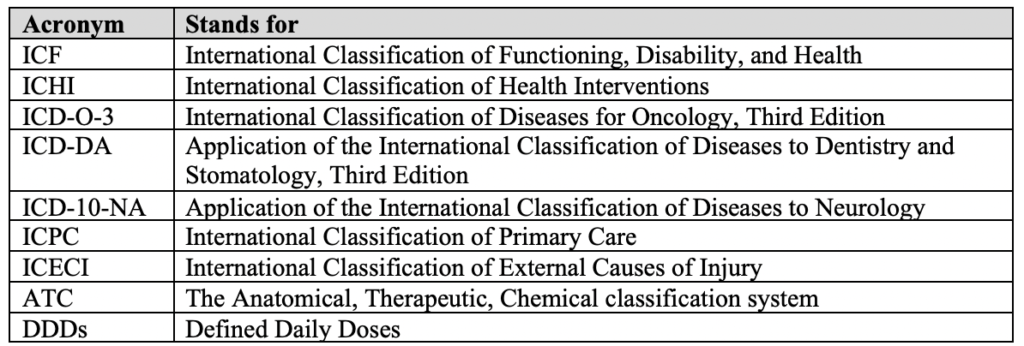In a situation like the one the world is experiencing now, where there is an epidemic or a pandemic, we must know how to read and deal with data on the WHO website. Most of the data and diseases on the WHO websites and represented through standard codes. International classification of diseases (ICD) is one of the most important standardized codes as it is relevant to the diagnostic classification of diseases.
This blog will introduce a primer to the WHO Family of International Classifications with a focus on ICD.
An introduction to FIC and ICD
ICD is a member of the family that became the main pillar for healthcare research, especially when it comes to studies assessing common patterns and forecasting. It has been translated into 43 languages. ICD is being used in 117 countries to report mortality data and for monitoring health status.
It can be considered a context for coding of the causes of illness and injury that is done on a global scale under the supervision of the WHO. According to the WHO, ICD can be defined as “International standard diagnostic classification for all general epidemiological and many health purposes”.
ICD is revised periodically to include changes in the medical field.
The scope of WHO-FIC includes:
- Health status Environmental health.
- Health care (including rehabilitation) Food standards and hygiene.
- Health policy and planning Health screening.
- Disability policy and planning Prevention of hazardous and harmful drug use.
- Communicable disease control Public health research.
- Selected health promotion External causes of injury.
- Organized immunization Occupational health.
The following diagram is a simple representation of the FIC, followed by a table describing the acronyms used in the diagram.

Figure 1: WHO – Family of International Classifications

Table 1: Acronyms related to the WHO Family of International Classification
Different revisions of ICD were released. There are differences between each release and the other. Currently, the most adopted revisions in the world are ICD-9, ICD-10, and ICD-11.Table 1: Acronyms related to the WHO Family of International Classification
How ICD-10 is different from ICD-9?
- ICD-10 is included in 3 Volumes while ICD-9 is included in 2 volumes only.
- ICD-10 codes are Alpha-Numeric while ICD-9 codes are numeric-only.
- Some chapters of ICD-9 are rearranged in ICD-10.
- Some titles that were used in ICD-10 are changed in ICD-10.
- Conditions are regrouped in ICD-10.
- ICD-10 has twice the number of categories than ICD-9.
- Minor changes in the coding rules for mortality took place.
What is new in ICD-11?
- ICD-10 contained 14,400 items. There are 55,000 in the ICD-11.
- 31 countries were involved in field testing for ICD-11. 1,673 participants are taking part in 112,383 code assignments.
- ICD-11 includes circumstances affecting health (dissatisfaction with the situation at school and low levels of personal hygiene).
- In ICD11, diseases that occur on the background of HIV infection have a special code.
- All types of diabetes are described in detail.
- ICD-11 includes a section for “Objects involved in the injury”. Doctors can encode any event in your life that affected your health.
- “Transsexualism” and other “gender identity disorders” are mentioned in a new section concerned with sexual health instead of mental and behavioral disorders.
- The diagnosis of “hermaphroditism” is not present anymore. Instead, this condition is pointed to as a “violation of gender formation”.
Uses of ICD
ICD is used to classify diseases recorded in different records like death certificates and medical records.
Moreover, it can be used in analyzing general health for population groups, monitoring incidence, the prevalence of diseases, determining characteristics and circumstances of individuals affected by a specific disease for evidenced-based decision-making. It can also help in observing reimbursements and enforcing quality standards.
Its uses according to the WHO:
- It can be used to Classify epidemiological and healthcare problems, enable storage and retrieval of diagnostic information (clinical & epidemiological).
- Compilation of national mortality and morbidity.
Its uses according to the CDC (Centers for Disease Control and Prevention):
- Promoting international comparability in the collection, processing, classification, and presentation of mortality statistics.
- Reporting causes of death of the death certificate.
Clinical Classifications Software (CCS)
Clinical Classifications Software (CCS) for the ICD-10-CM database is available on the HCUP website in raw form, on John Snow Labs (JSL) repository website, where the reader can get it in a clean and normalized form.
The previously mentioned data package should be of great use to decision-makers, healthcare researchers, medical students, and even for those who are unfamiliar with the medical terminologies as all abbreviated terms are replaced with full form, unlike the Healthcare Cost and Utilization Project (HCUP) original datasets which are full of abbreviations.
The provided link offers 6 datasets:
- Clinical Classification Software for ICD-10 CM.
- Clinical Classification Software for ICD-10 PCS.
- Clinical Classification Software for Mortality Reporting Program.
- Multi-Level Clinical Classification Software ICD-10 CM and PCS Codes.
- Single Level Clinical Classification Software ICD-9 Diagnosis Codes.
- Single Level Clinical Classification Software ICD-9 Procedure Codes.
You can make a difference
The WHO has designed a web platform for ICD-11 where you can add your inputs. Your inputs may include your comments regarding the classification structure and content. You can also provide proposals to change ICD categories, definitions of diseases, or participate in field testing.
With the integration of classification systems like ICD-11 into Generative AI in Healthcare, tools such as a Healthcare Chatbot can deliver more accurate health information, enabling patients and providers to engage with a robust, up-to-date understanding of medical classifications and improve overall healthcare delivery.





























